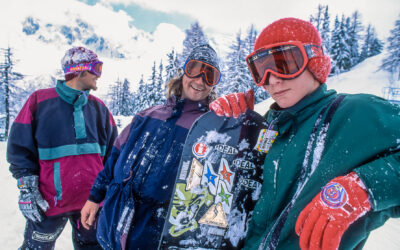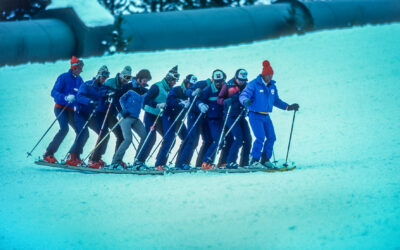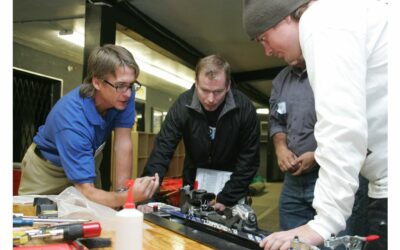
As I’ve been telling you since I first ascending this pulpit, there is nothing you can do to help your skiing more than procuring a properly fit ski boot. There is no way to compensate for its absence, no alternative that makes the choice of boot immaterial. It is, in a word, essential.
Given the primordial importance of the bootfitting enterprise, I thought it might be instructive if you, Dear Reader, experienced a typical bootfitting interaction from the bootfitter’s point of view. Let’s suppose introductions are over and you’re now seated before me, eager to get the process underway.
Before I even ask you to show me your bare feet, I’ve been observing your stance and seated posture. I’m trying to gauge, in general, how much of an athlete I have in front of me. Some people glide through the world; others, shall we say, don’t. It’s too early to form judgments, of course, but information gathering starts at, “Hi, my name’s Jackson.”
I’m going to ask to see your bare feet and to take a look at whatever you brought as a ski sock. The sock will get an immediate verdict, yes, these will be fine, or no, let me get you something that will make a happy outcome more likely. Your bare feet will usually require a little re-positioning, as I want them hip-width apart, right angle at the knee and hip, feet aimed at me.
While I’m guiding your bare tootsies into a neutral position, I’m feeling for any abnormalities and asking questions like, “Any history of injury I should know about? Any areas that always give you trouble?” I’m scanning typical problem areas for telltale signs of issues I’ll have to deal with no matter what boot I target.
I’m going to measure the length of both your feet, and usually the heel-instep perimeter (HIP). Other interesting measurements – notably arch length and width – I don’t need to measure as the evidence is staring me in the face. What I can’t tell just by eyeballing are the flexibility of your arch and your ankle range of motion, so I’ll conduct a couple of 5-second tests to see how healthy and receptive to support your arches are and if your ankle ROM is compromised.
As I scan your foot and lower leg, I’m looking at how each element – calf, ankle, heel, midfoot and forefoot – looks relative to the whole. For example, if am I looking at a big piston of a calf mounted on a slender lower leg and ankle, with a high arch, how am I going to fit this amalgam? What oddity do I prioritize?
The answer is always, prioritize the bones of the rear foot. In this case, I’m going to need a low-volume shell, even though the calf and midfoot are screaming for something, anything, larger. Why do I go this route? Because the hardest part of the boot to modify is the heavily reinforced heel and ankle area, so I want the ideal match of skier and boot to be in this zone. The calf pinch I can deal with by raising the heel a tad, which will annoy the arch until I expand that area, which is easy to do, much simpler than trying to carve out new territory in the heel.
Now I’m ready to hear your skiing history, where you’ve been, where you dream of going, what runs you seek out, what you wouldn’t ski on a bet. I’m always interested in your current boots and why they’ve fallen out of favor. Is there anything in particular you want to try on, because of a friend’s recommendation or a previous, positive experience? Left to my own devices, I won’t be making a lot of trips to the stock room, so if you have a model in mind, now is the time to mention it.
A good bootfitter doesn’t just know about feet and how they behave in the hostile environment of ski boots; he or she also needs to know the strengths and weaknesses of every model in inventory. It’s the ideal marriage of boots and feet that we’re trying to consummate; the more one knows about both, the better the probable outcome.
Before I put you in the first model and size I’ve selected for you to try on, I want to revisit your arch. No matter what boot I retrieve, the insole that comes with it will be a nothing-burger, a mere placeholder for a device that actually does something. That “something” is full contact with the zillions of proprioceptors in your arch, a key component in your balance system that beg to be connected, and need support to do their job. While off-the-rack solutions can’t usually achieve the perfect match that’s attainable in a custom insole, even an approximate fit is better than the nothing-burger.
At this point, I know a lot about what boot I’m leaning towards, but there’s still one critical factor I can’t predict: your ability to flex a ski boot. Every model has a designated flex index; the higher the number, the stiffer the boot. In most cases, you want the stiffest boot you can comfortably flex forward while standing on the boot bench. The first boot I present may not be the stiffest option available, but I will be shooting for the highest flex I suspect the customer can manage.
Boot pricing is directly correlated to flex: the higher the flex number, the higher the price. Usually, each 10-point jump on the flex index triggers a $100 bump at retail. The best advice being proffered in today’s Revelation is: DO NOT GET A SOFTER BOOT JUST TO SAVE $100. The boots you buy today may be with you for the next decade. If you want to improve as a skier over that span – no matter what form said improvement may take – a closer-fitting, more supportive and more responsive boot will make it possible. The C-note you spend to get the better boot is a pittance over the lifespan of the boots and a paltry fraction of the total cost of one’s equipment, not to mention lift passes, lodging, transportation… You get the idea.
Once I have you in the right boot, in the right flex and you have solid underfoot support, we’re done. Almost. I want to see you flex the boot and rock side to side. I’m looking for stance and alignment issues that could limit your performance and/or comfort. Based on what I see, I may elect to slightly shift your ramp angle or modify your lateral cuff alignment.
That’s it. There are always other accoutrements to consider, such as a heated boot bag, a Booster strap or a custom inner boot, but job one is done and dusted. Shall we look at skis?
Related Articles
Reader Comments on Why Ski Sales Have Shrunk
In this week’s Revelation, I posted my top ten (twelve, actually) reasons why skis sales have shrunk, along with the musings of two Dear Readers on the subject. Note that the topic’s focus was ski sales at retail, not skier or skier/rider participation rates, subjects that are certainly related but just as certainly not the same.
Below are verbatim reader responses culled in the last 48 hours. I’ve corrected the odd typo, but otherwise left these contributions intact.
My thanks to all who took the time to tell their tales. – J
Top Reasons U.S. Ski Sales Have Shrunk
[As I wrapped up an earlier Revelation, I proposed to my beloved readership that they share their list of the top ten reasons U.S. ski sales have shrunk. I elicited only two written responses, so I’ll reproduce both here in their entirety, along with my musings on the subject. Consider these submissions tinder to light a fire under you, Dear Reader, to submit a list of your own.]
From Rick Pasturczak
1. Snowboarding-
I’ve noticed most snowboarders are 12 to 20 years old and once they become an adult, almost all stop. While I noticed most skiers continue on.
2. High school and college sports-
Schools now require practicing sports during Christmas and spring breaks taking away opportunities to hit the slopes and family vacations to the mountains. I’ve been told by many parents the coaches forbid them to ski.
3. Travel costs-
Lodging, airfare, ground transportation, and lift tickets.
4. Video games
5. Cost of lessons make it expensive to improve.
6. Confusing selection of equipment
7. Magazines and movies showing extreme skiing
8. Cruising. We need some resorts to be all inclusive.
9. Baggy pants. Bring back stretch pants and sex appeal.
10. Last, we need mother nature to be more consistent with snow.
The Making of a Skier, Part X: The Mechanics & Managers Workshop Tour
When I left Salomon in the spring of 1987, my motivations could be distilled into three principal components:
• The parent company declared it was moving its Reno-based North American HQ back from whence it came. Neither I nor my family had the slightest desire to return to New England.
• I felt I was spending more energy battling factions within my own company than I was out-flanking our competition. I’d worked more or less without a break since June of 1978. My thin veneer of patience cracked.
• I wanted to write screenplays. Not that I had demonstrated any talent for creative writing or had any training in the field. I’d written reams of technical swill, brochure copy, training manuals and memos which created the illusion that I could at least write something, so why not screenplays?
Note that none of these factors involves finding a new job. At the time, I didn’t want to resume wearing the shackles of employment as they would interfere with my ludicrous screenwriting ambitions. Then the stock market went into a tailspin in October, crippling what little equity I’d managed to accrue on my minimalist salary. Oops.





